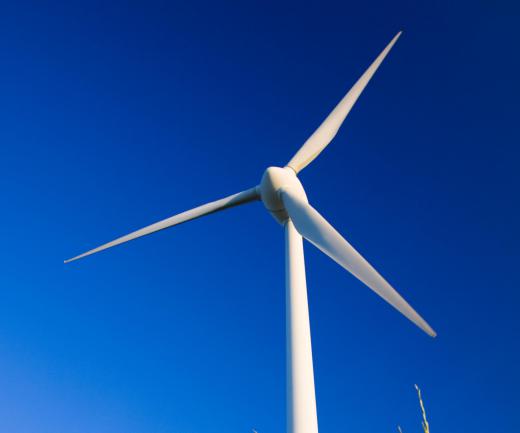What is a Windmill?
 Mary McMahon
Mary McMahon
A windmill is a machine that harnesses wind energy for a purpose like grinding grain, pumping water, or generating electricity. Some people prefer to use the term “wind turbine” to refer to one that is used for electricity generation, differentiating energy-generating machines from those designed for other functions. While the popularity of windmills waned with the rise of other sources of energy, they continue to be widely found around the world, and especially in remote areas, these devices sometimes provide the only source of energy for the surrounding community.
The earliest documented attempt at building a windmill occurred in Ancient Greece around the first century CE. Apparently, the technology didn't catch on, because the Persians developed their own version 400 years later, coming up with versions that were seen by Europeans during the Crusades. Some of the Crusading knights brought the technology back to Europe with them, and Europeans started building these devices in the 12th century, making several adaptations to the Persian design. The Chinese also appear to have picked up the technology from the Persians.

The basic form hasn't changed since the first century. It has a set of blades or slats mounted on a central axis that is designed to revolve as the slats are pushed by the wind. The axis connects to a system of gears to turn machinery that can do things like operate a millstone for the purpose of grinding grain or pumping water.
Many windmills are designed to rotate, so that the operator can take advantage of prevailing winds. Early European designs were very simple, consisting of little more than long poles attached to the blades, but in the 14th century, people started to construct towermills, which had a fixed tower base and a rotating top. The development of the tower mill allowed for the construction of facilities directly beneath the blades, maximizing energy efficiency.

These structures are a distinctive part of the landscape in many regions of the world, as by their very nature they are tall and quite imposing. Those in some regions have become particularly famous. Holland, for example, is dotted with windmills, many of which continue to be used to control floodwaters in low-lying areas, and those in La Mancha in Spain are famous thanks to the novel Don Quixote, in which the eponymous protagonist is seen mistaking them for giants and attempting to fight them.
AS FEATURED ON:
AS FEATURED ON:














Discussion Comments
@anon122329 - I think that a wind turbine is something that is only used for generating electricity. A wind turbine is a windmill, but a windmill is not necessarily a wind turbine.
There are still plenty of traditional windmills around that are used for things like grinding flour. I know a small town near me put one up a couple of decades ago as a kind of publicity stunt to give the town something unique so people would visit.
And the bread you can get there, made from the stone ground flour is delicious. Apparently they brought in the stones used for the grinding from the Netherlands and everything.
It is bizarre to be traveling through a random small town and suddenly come across what looks like a genuinely old windmill though, still flying in the wind.
I imagine they could hook it up to work as a turbine as well if they were so inclined but I'm not sure that they have done that.
@anon66504 - Generally a modern wind turbine will generate electricity by converting kinetic energy (which is made when the wind moves the arms of the windmill) into electricity. I'm not entirely sure how this actually works, but it has something to do with magnetic forces. The energy is generally stored in a battery array, or directed entirely into the local electricity grid.
Sometimes they are still used as they once were converting kinetic energy to mechanical energy. This is when they are attached to something that needs to move, like a water pump and used to make that thing move directly.
That kind of design is much less common now than it used to be, as most new windmills are being used for electricity.
They can be a really good idea if you've got a lot of spare, windswept land.
What is the difference between a windmill and a wind turbine?
i think you should also tell us about how does a windmill generate electricity?
Post your comments